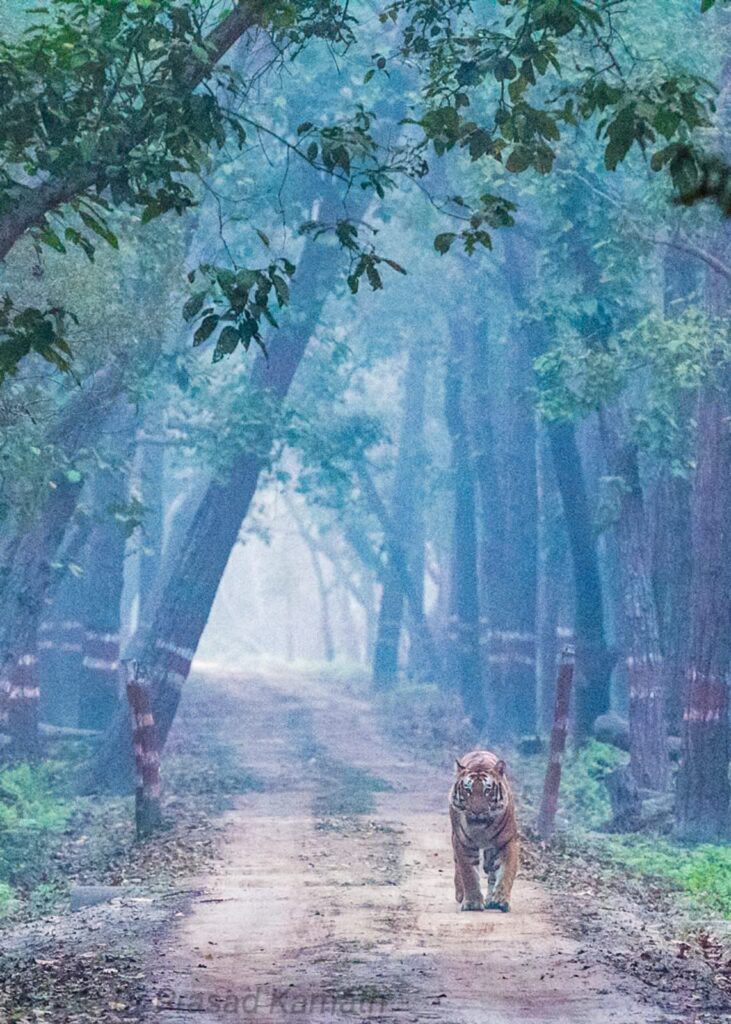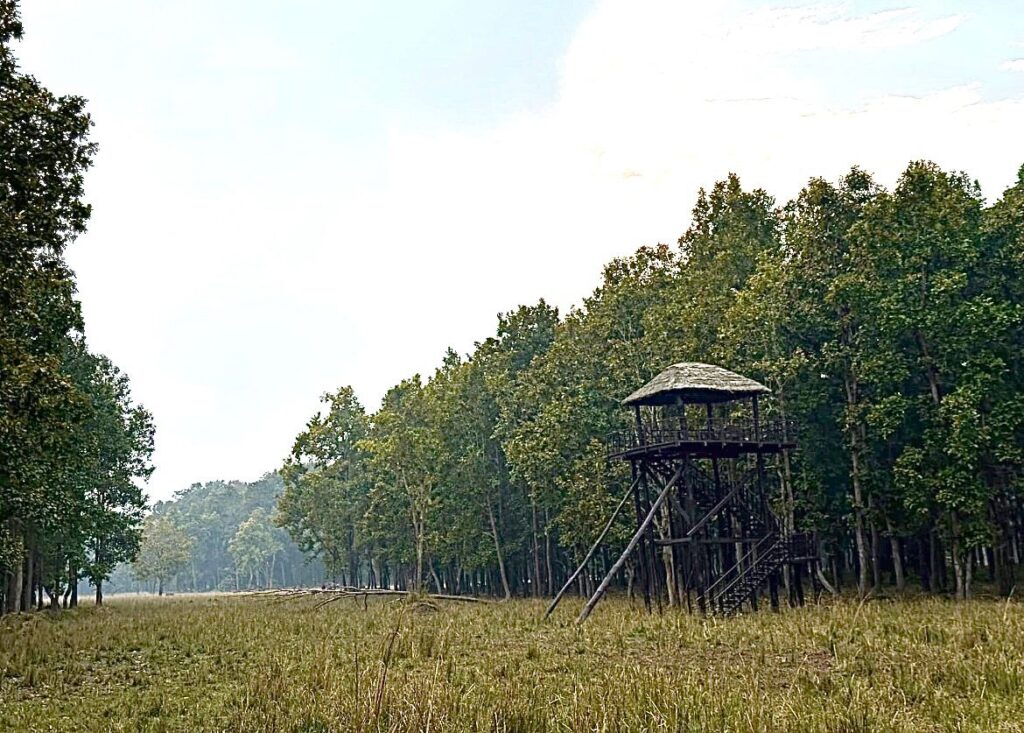The morning mist clung to the dense Sal trees as the first rays of the sun pierced through the forest canopy. A Cheetal Stag stood frozen, ears perked, as the jungle echoed with the distant, calls of peafowl . This was Pilibhit Tiger Reserve – a wild, untamed land where nature still ruled supreme.
Nestled in the foothills of the Himalayas in Uttar Pradesh, Pilibhit is not just a sanctuary for wildlife; it is a living, breathing ecosystem, home to one of India’s most thriving populations of the majestic Bengal tiger. The reserve stretches across a vast expanse of grasslands, riverine forests, and swamps, forming an essential corridor for tigers that move between India and Nepal.

A lone tiger named Rocket, by the locals,a testament to his speed in younger days, silently prowled through the tall golden grasses, his amber eyes fixed on a herd of spotted deer grazing by the Sharda River. The river, a lifeline of this ecosystem, shimmered in the morning light, its banks lined with tracks of leopards, tigers , wild boars & deers. With a swift and calculated move, Rocket lunged, his muscles rippling beneath her striped coat. A moment later, silence settled once more, save for the rhythmic rustling of the wind through the grasslands.

Pilibhit is not just about the tiger. It harbors a rich variety of life – marsh crocodiles bask on sandy riverbanks, the elusive fishing cat lurks in the undergrowth, and vibrant Sarus cranes wade through marshes. Each dawn brings the melodious calls of over 300 bird species, making the reserve a paradise for ornithologists.
But Pilibhit’s story is not without conflict. The proximity of human settlements has led to occasional encounters between villagers and big cats. Conservationists, armed with knowledge and compassion, work tirelessly to educate the local communities, promoting coexistence and sustainable livelihoods. The success of these efforts was evident when Pilibhit won the TX2 Award for doubling its tiger population in less than a decade—a rare conservation triumph.

As the sun dipped below the horizon, painting the sky in hues of orange and purple, the jungle prepared for another night. Stars twinkled in the sky, like tiny lanterns, and the distant call of a jackal broke the silence. Somewhere in the heart of the reserve, Rocket rested beneath a banyan tree, his breath steady, his home safe – for now.
Pilibhit is more than a tiger reserve; it is a testament to nature’s resilience, a reminder that when humans and wildlife share the land with respect, the jungle thrives. And as long as the tigers of Pilibhit continue to roar, the spirit of the wild will endure.
© Dr Prasad J. Kamath, Gynaecologist; Endoscopic Surgeon.
A Nature Enthusiast by passion.



From Tipeshwar, Yavatmal District Maharashtra.
Delighted to see this post in CLN Online. Am taking the liberty of sharing a forward that I received recently on the need for humans to be closely connected with Nature:
In The Lost World of the Kalahari, Laurens van der Post recounts his time living among the indigenous people of the Kalahari Desert. He describes their shock when they discovered that he couldn’t hear the stars.
At first, they assumed he was joking or lying. But when they realized he truly couldn’t hear them, they were deeply saddened. To the Bushmen, being unable to hear nature was the most serious affliction a person could have—a sign of profound disconnection from the world around them.
Dr Kamath’s article has triggered my thoughts towards an interesting historical incident which I had read and would like to share. In December 1796, The Kodavas had seized some elephants which were being transported from the Nagarhole jungles to Mysore. The Kodavas had forcibly retrieved the elephants as they claimed that the elephants were captured from their “Coorg country” and thus they would not allow them to leave for Mysore.
The irritation was enough for Tipu Sultan to accompany his troops to the border of Coorg and camp there. The King of Coorg also kept his forces prepared. East India Company officials became concerned, and the matter ended as an anticlimax with the Sultan retreating back to Srirangapatna.
This is being narrated only to demonstrate the fierce attachment that the Kodavas had towards their thick jungles. Sadly, post the merger, timber merchants – essentially from neighbouring Kerala had a field day and decimated the plantations by ruthlessly cutting majestic trees. The next wave was the large scale felling of timber after TATA Coffee bought Consolidated Coffee in 1991 which set the trend in the district where companies like BBTC followed suit. Sadly, our verdant forests also got stripped of timber forcing the animals to move outside the safe haven that the forests provided. And so the story unfolds…
PILIBHIT was the story of Coorg in the year 1950. The preservation of forests in Kodagu post 1956 merger has deteriorated significantly.
Nagarhole Tiger Reserve derives its name from naga, meaning snake and hole, referring to streams. It was set up in 1955 as a wildlife sanctuary and later upgraded into a national park in 1988. The park was declared a tiger reserve in 1999.
Unfortunately the sanctuary has been associated with controversial tiger conservation projects which drew media attention and later discontinued due to allegations and counter allegations.
On a more positive note, Project Tiger launched by the Government of India has recorded tremendous success with the Tiger population recording a five fold increase. This has also benefited the increase in all other wildlife in the the designated sanctuaries.
Reading this article of Dr Kamath is a significant coincidence. Last evening three elephants were chased into our coffee plantations by the Forest Department and the instructions were not to panic, let the pachyderms take refuge and calm down and sure enough they crossed over the Thadiyandamol range and perhaps went back to where they came from.
The human-animal conflict is largely the utter disregard from the people who encroach forest land for cultivation. The area of Kodagu is 410775 hectares, out of which 134615 hectares are forests. It means about 33% of the land is covered by forests. Why is it that there is nothing for these animals to eat in the forest? A trip into Nagarhole Sanctuary will show the monoculture of teakwood trees, overgrown lantana and water holes:tanks/lakes in complete disrepair with no water. The animals have no choice but to seek greener pastures and in the extreme the garbage dumps of towns.
There has to be a concerted and compassionate effort to remedy the situation. It is possible if people ar large cooperate with the Forest Department – who should be willing and encourage such participation. Most importantly progress should be monitored and respective Range Officials be made accountable.
My visit to Tadoba National Park in April 2022 was pure bliss. I follow CLN Online and felt compelled to share some select pictures with the readers – it was an incredible experience. I can well imagine what Dr Prasad Kamath felt during his visit to Pilbhit Tiger Reserve!!
Preserving native trees,water bodies, mountain grass lands, Shola forests is essential for maintaining biodiversity, protecting ecosystems, and ensuring a sustainable environment for future generations.
Extremely well written article that is so relevant for what can be done/achieved at Nagarhole National Park in Kodagu.
Without holding anyone responsible for the state of the Park, it is possible to achieve what has been done at Pilbhit Tiger Reserve if a proper plan is drawn up and executed. Just holding the Forest Department responsible for the apathy in the regeneration of the forests is counter productive.
For starters, inviting people who have had successful regreening experiences and then working out a long term agenda with the Forest Department and District Administration is critical. I understand that the Coorg Wildlife Society has had a recent election of young and committed members in the new Governing Body. Perhaps they should take the lead 🤔
Very nicely written. Captures the early morning jungle ambience very well with a nice photo